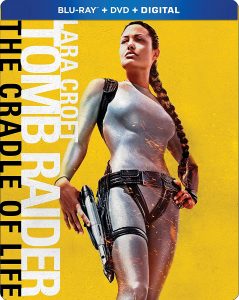With Alicia Vikander’s “Tomb Raider” relaunch now in theaters, I figured it’s a good time to watch “Lara Croft: Tomb Raider” (2001), which I had seen back in the day but didn’t remember a darn thing about, and “Lara Croft: Tomb Raider – Cradle of Life” (2003), which I barely knew existed.
The most obvious winning element of the “Croft” pictures is that Angelina Jolie looks like she unanimously won a cosplay contest as the video-game heroine, who debuted in 1996 and was known in wider pop culture circles for having large breasts. The British Lara is part Indiana Jones, in that she’s an archaeologist, and part James Bond, in that she has access to all the latest field tech support – via Bryce (Noah Taylor, the manager from “Almost Famous”) – and logistical support – via Hillary (Chris Barrie).
But Lara is independently wealthy, so she doesn’t have to rely on grants to go on digs – or crazy adventures – like Indy, nor does she have to answer to government bosses like Bond. Like many adventuring heroes, she’s a loner, and this is the biggest problem with the first film: Through no fault of Jolie, Lara is cold and invulnerable. She faces incredible odds in fights – like when the bad guys invade her mansion to steal an artifact, or when ancient stone monsters detach from a temple to smash her – and smirks her way through them. Afterward, she still looks like a cosplay contest winner. While his survival might be equally miraculous, Indiana Jones at least looks like he’s injured.
“Cradle of Life” consciously solves Lara’s “loner” problem via the Scottish Sheridan (Gerard Butler), with whom she teams up. They have great chemistry, their background as lovers is intriguing, and Lara can still be an independent woman — with Sheridan as the sidekick – while getting to interact with other humans. The first film serves up a pre-Bond Daniel Craig as Lara’s archaeology rival and possible romantic partner, but he’s on screen too little. Because of this correction, “Cradle of Life” is one of those sequels that is easily better than the original.
The “Lara Croft” films’ production design is outstanding – almost on par with “Indy” – as we’re taken to evocative settings, from ice caves in the first film to a pyramid buried under the ocean in the second. It falls short in the action sequences, though, as directors Simon West and Jan de Bont sometimes mix in slow-motion shots that maybe were cool in the Aughts but date the films now.
Although the “Lara Croft” theme music is sweeping – composers Graeme Revell and Alan Silvestri work from the game’s roots – the music choices in the action sequences, particularly in the first film, lean toward techno and electronica beats. This makes the sequences feel more generic than they deserve to, while reminding us of the fight’s CGI aspects, such as the stone warriors.


Lara glibly works her way through these threats in choreographed fashion; even when she tricks a shark into carrying her to the ocean’s surface in “Cradle of Life’s” opening sequence, it feels expected rather than desperate. It’s hard to get a true sense that Lara is in peril when we know she has planned for every possible scenario.
Nor in romantic entanglements does Lara show much vulnerability, and therefore she remains distant from us. At the end of “Cradle of Life,” she has a regretfully tragic showdown with Sheridan, and in the next scene she’s sharing one last laugh before the credits with her African allies. While these films have a general sense of lightness (compared to the typical much-more-violent actioner), they have only a few smiles and zero laughs.
That’s their biggest flaw: Everything is in place for fun adventure movies, but the filmmakers hope the fun will come from the lightness and craziness of the adventure rather than from character interactions. And there aren’t any substantial character arcs for Lara. The first film suggests her archaeologist father (Jon Voight, Jolie’s real-life dad) might be alive — in film shorthand, when someone is merely “missing,” they usually pop up later – but it doesn’t capitalize. Lord Richard Croft’s cryptic clues for finding an artifact that will determine the fate of the world are for the sake of giving his daughter a challenge – that’s enough of a hook for a game, but not for a film.
Even after the livelier “Cradle of Life,” Lara remains a cipher, a live-action version of her video-game character. There are some pleasures to be gained from watching Lara do her thing in gorgeous environments, as Jolie’s charisma carries us through. Between the third and fourth “Indy” films, if big-screen adventure had a name, it could have been Lara Croft; unfortunately, we know too little about her beyond her name.
The “Tomb Raider” video games are wish fulfillment: We like to think that if money was no concern in our lives, we’d whip ourselves into fighting shape, hire fine assistants and go on globe-spanning adventures — and the games put us in Lara’s shoes. The first two movies don’t add much to the mythos; they just suitably translate it.
“Lara Croft: Tomb Raider”: 2.5 stars
“Lara Croft: Tomb Raider – Cradle of Life”: 3.5 stars

